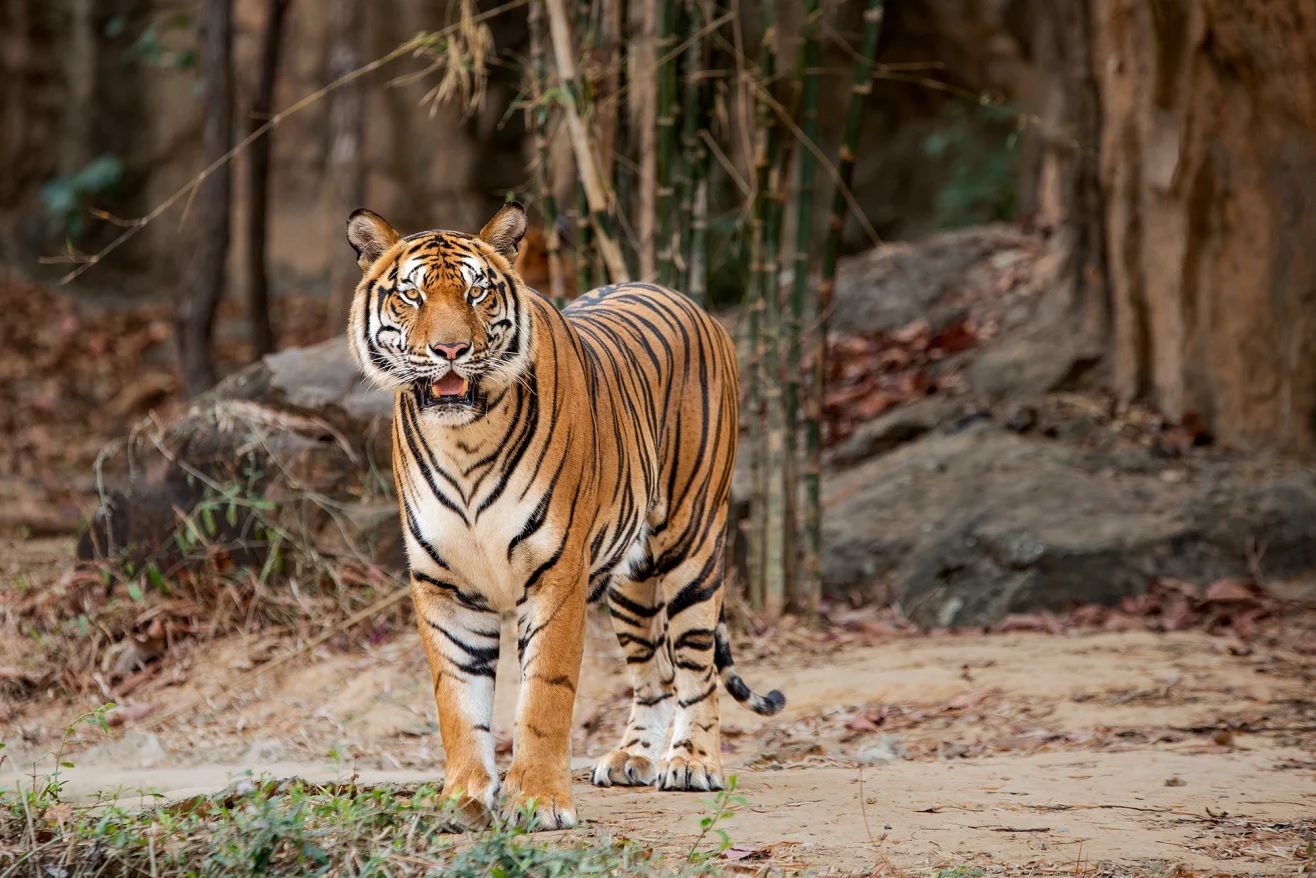থাইল্যান্ডের ডং ফায়ায়েন-খাও ইয়াই ফরেস্ট কমপ্লেক্সের গভীর চিরসবুজ অরণ্যে সংরক্ষণবিদরা একটি বিশেষ ফাঁদ বসিয়েছেন—বাঘ ধরার জন্য। এটি কোনো শিকারির ফাঁদ নয়; বরং বংশগতভাবে টিকে থাকা অবশিষ্ট ইন্দোচীনা বাঘদের রক্ষা করার প্রচেষ্টা। ৬ হাজার বর্গকিলোমিটার বিশাল এই অরণ্যে বর্তমানে মাত্র ২০ থেকে ৩০টি বাঘ রয়েছে। এদেরই বাঁচিয়ে রাখতে কঠোর পরিশ্রম করছেন গবেষকরা।
ডিপিকেওয়াই-এফসি এলাকায় বাঘের স্থবিরতা
থাইল্যান্ডে বাঘ সংরক্ষণে কিছু সাফল্য থাকলেও তার বেশিরভাগই পশ্চিমাঞ্চলের বনাঞ্চলে। সেখানে ২০০৭ থেকে ২০২৩ সালের মধ্যে বাঘ সংখ্যা তিন গুণ বৃদ্ধি পেয়েছে। কিন্তু ডং ফায়ায়েন-খাও ইয়াই এলাকায় বাঘের সংখ্যা বাড়েনি। পর্যাপ্ত বন ও বিস্তৃত জায়গা থাকা সত্ত্বেও নতুন বাঘ দেখা যাচ্ছে না দীর্ঘদিন। কিছু এলাকায় তো এক দশকেরও বেশি সময় ধরে কোনো বাঘের চিহ্ন পাওয়া যায়নি।

এই অবস্থার কারণ জানতেই গবেষকরা ২০২৫ সালের শুরুতে তিনটি বাঘকে জিপিএস কলার পরিয়ে অনুসন্ধান শুরু করেন।
জিপিএস কলারে বাঘ গবেষণার উদ্দেশ্য
ক্যামেরা ট্র্যাপিং বাঘের উপস্থিতি জানালেও তাদের জীবনযাপন, সীমানা, চলাচল, শিকার—এসব জানতে হলে আরও গভীর তথ্য দরকার ছিল। তাই বাঘগুলোর গলায় কলার পরিয়ে প্রতি ঘণ্টায় অবস্থান নথিভুক্ত করা হচ্ছে। ঘন জঙ্গলে স্যাটেলাইট সংকেত সবসময় পৌঁছায় না, তাই কলারে ডেটা সংরক্ষণ থাকে। ব্যাটারি শেষ হওয়ার কাছাকাছি কলারটি নিজে থেকেই খুলে পড়ে, যাতে গবেষকরা তা সংগ্রহ করতে পারেন।
গবেষণার তিন বাঘ: শ্রীকোসা, চান্ত্রা ও পিয়ানপর্ন
ডিপিকেওয়াই-এফসির দল তিনটি বাঘ বেছে নিয়েছিল—একটি প্রাপ্তবয়স্ক পুরুষ বাঘ শ্রীকোসা এবং দুই বোন উপবয়স্ক স্ত্রী বাঘ চান্ত্রা ও পিয়ানপর্ন। বাঘ ধরার পর পশুচিকিৎসকের তত্ত্বাবধানে অল্প সময়ের মধ্যেই কলার বসানো হয় এবং নমুনা সংগ্রহ করা হয়।

অদ্ভুত শিকার: ছোট প্রাণী, এমনকি অপ্রত্যাশিত খাবার
জিপিএস ডেটা দেখায়, এ এলাকার বাঘরা বড় শিকার যেমন গাউর, সাম্বর বা বানটেংয়ের বদলে প্রায় ১০ কেজি ওজনের ছোট প্রাণী—বুনো শূকর বা মুণ্টজ্যাক হরিণ—বেশি শিকার করছে। এতে বোঝা যায়, এই অঞ্চলে বড় শিকার কমে গেছে।
আরও বিস্ময়কর হলো বাঘ চান্ত্রার খাদ্যাভ্যাস—সে মূলত হগ ব্যাজার খায়। এমনকি নরম খোলসের কচ্ছপ এবং পানি মনিটর টিকটিকিও পাওয়া গেছে তার কিল সাইটে—যা থাইল্যান্ডের বন্য বাঘের খাদ্যতালিকায় আগে কখনো নথিভুক্ত হয়নি।
চান্ত্রার আচরণগত বৈশিষ্ট্য
চান্ত্রা কিছুটা আলাদা। একই বয়সের বোন পিয়ানপর্নের তুলনায় তার দেহ ছোট, আর তার গৃহক্ষেত্র মাত্র ২৪ বর্গকিলোমিটার—বোনের সীমানার অর্ধেকেরও কম। তার লেজে একটি বাঁক আছে, যা কিছু প্রাণীর ক্ষেত্রে অরুচিকর জিনগত সমস্যার ইঙ্গিত দিতে পারে। ছোট দলে সীমিত জিনগত বৈচিত্র্য থাকায় এটি গবেষকদের চিন্তায় ফেলেছে।

সংরক্ষণ চ্যালেঞ্জ: শিকারি, রাস্তা ও উন্নয়ন প্রকল্প
গবেষকেরা জানাচ্ছেন, ডিপিকেওয়াই-এফসির কিছু অংশ প্রায় ‘খালি বন’—অর্থাৎ বাঘ নেই। তাই ভবিষ্যতে বনাঞ্চলে হুমকির বিশ্লেষণ করা হবে, বিশেষত শিকারি কার্যক্রম, বাঘের খাদ্যের অবৈধ শিকার, রাস্তা ও বাঁধ নির্মাণের মতো প্রকল্পের প্রভাব। ৩০৪ নম্বর মহাসড়ক এবং প্রস্তাবিত একটি বাঁধ শিকারিদের সহজ প্রবেশাধিকার দিতে পারে—যা বড় ঝুঁকি।
যদি এসব হুমকি কমানো যায়, তবে শিকার-প্রাণীর সংখ্যা বাড়বে, তার সঙ্গে বাড়বে বাঘের সংখ্যাও।
জিপিএস কলার প্রকল্পটি এখনও প্রাথমিক পর্যায়ে থাকলেও গবেষকেরা আশাবাদী। প্রথম বছরের অভিজ্ঞতা তাদের ব্যাপক সহায়তা দেবে, এবং ভবিষ্যতে আরও তহবিল পেলে তারা পুরো বাঘের সংখ্যা নিয়ে আরও বিস্তারিত তথ্য সংগ্রহ করতে পারবেন।








#tiger #Thailand #wildlife #conservation #gpscollar

 সারাক্ষণ রিপোর্ট
সারাক্ষণ রিপোর্ট 


















